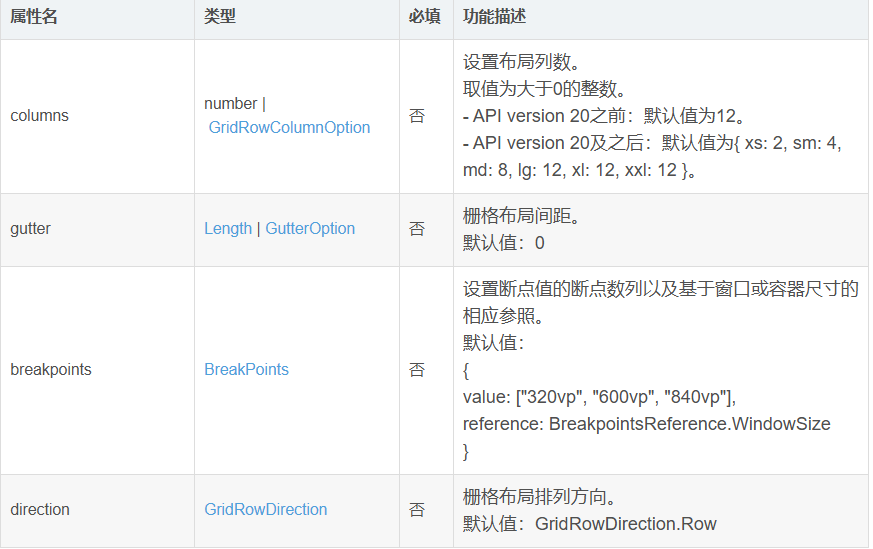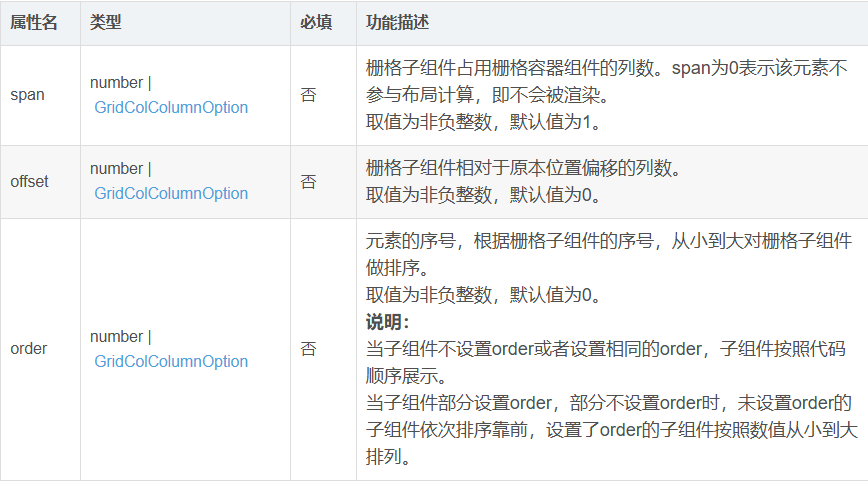一、引言:网格布局 —— 现代 UI 的结构化基石
在鸿蒙应用开发中,GridRow 与 GridCol 组件构成了构建高效网格布局的核心体系。作为线性布局的进阶方案,网格布局通过行列交织的结构化设计,将界面划分为规则的单元格,完美适配商品展示、功能矩阵、图片墙等多元素排列场景。与传统布局相比,网格系统具有以下显著优势:
视觉秩序感:通过标准化的单元格排列,建立清晰的视觉层级
响应式能力:动态适应不同屏幕尺寸,自动调整行列分布
开发高效性:减少布局嵌套,通过声明式语法快速实现复杂排列
本文将系统解析这两个组件的核心机制、属性配置与实战技巧,助你掌握现代化界面布局的关键技术。
二、核心概念与基础架构
2.1 网格布局的设计哲学
GridRow 与 GridCol 基于二维坐标系设计:
GridRow:水平方向(行)布局容器,管理子组件的列分布
GridCol:垂直方向(列)布局容器,管理子组件的行分布
协同工作:两者嵌套使用可构建完整网格体系,类似表格的行列结构
这种设计使开发者能够以 "单元格" 为单位规划界面,通过统一的间距、尺寸规则建立视觉一致性,尤其适合需要展示大量同类数据的场景。
2.2 基础语法与最简实现
GridRow 基础示例
// xxx.ets@Entry@Componentstruct GridRowExample { @State bgColors: Color[] = [Color.Red, Color.Orange, Color.Yellow, Color.Green, Color.Pink, Color.Grey, Color.Blue, Color.Brown] @State currentBp: string = 'unknown' build() { Column() { GridRow({ columns: 5, gutter: { x: 5, y: 10 }, breakpoints: { value: ["400vp", "600vp", "800vp"], reference: BreakpointsReference.WindowSize }, direction: GridRowDirection.Row }) { ForEach(this.bgColors, (color: Color) => { GridCol({ span: { xs: 1, sm: 2, md: 3, lg: 4 }, offset: 0, order: 0 }) { Row().width("100%").height("20vp") }.borderColor(color).borderWidth(2) }) }.width("100%").height("100%") .onBreakpointChange((breakpoint) => { this.currentBp = breakpoint }) }.width('80%').margin({ left: 10, top: 5, bottom: 5 }).height(200) .border({ color: '#880606', width: 2 }) }}
复制代码
运行逻辑:GridRow 自动将子组件按水平方向排列,根据容器宽度与子组件尺寸计算列数与列宽。
GridCol 基础示例
// xxx.ets@Entry@Componentstruct GridColExample { @State bgColors: Color[] = [Color.Red, Color.Orange, Color.Yellow, Color.Green, Color.Pink, Color.Grey, Color.Blue, Color.Brown] @State currentBp: string = 'unknown' build() { Column() { GridRow({ columns: 5, gutter: { x: 5, y: 10 }, breakpoints: { value: ["400vp", "600vp", "800vp"], reference: BreakpointsReference.WindowSize }, direction: GridRowDirection.Row }) { ForEach(this.bgColors, (color: Color) => { GridCol({ span: { xs: 1, sm: 2, md: 3, lg: 4 }, offset: 0, order: 0 }) { Row().width("100%").height("20vp") }.borderColor(color).borderWidth(2) }) }.width("100%").height("100%") .onBreakpointChange((breakpoint) => { this.currentBp = breakpoint }) }.width('80%').margin({ left: 10, top: 5, bottom: 5 }).height(200) .border({ color: '#880606', width: 2 }) }}
复制代码
布局特点:GridCol 沿垂直方向排列子组件,支持通过 rows 属性显式设置行数。
GridRow:栅格容器组件,仅可以和栅格子组件(GridCol)在栅格布局场景中使用。 GridCol:栅格子组件,必须作为栅格容器组件(GridRow)的子组件使用。
三、核心属性详解:精准布局控制
3.1 GridRow 关键属性
进阶用法示例:
GridRow({ columns: 5, // 列数 gutter: { x: 5, y: 10 }, // 列间距 breakpoints: { value: ["400vp", "600vp", "800vp"], // 响应式断点 reference: BreakpointsReference.WindowSize // 参考窗口大小 }, direction: GridRowDirection.Row // 排列方向 }) { // 子组件... }
复制代码
3.2 GridCol 关键属性
典型配置示例:
GridCol({ span: { xs: 1, sm: 2, md: 3, lg: 4 }, // 列数 offset: 0, // 偏移量 order: 0 // 排序 }) { // 子组件... }
复制代码
3.3 动态布局管理
通过数据绑定与循环渲染实现动态网格:
@Entry@Componentstruct DynamicGridDemo { @State items: string[] = ['数据项1', '数据项2', '数据项3', '数据项4', '数据项5'] build() { GridRow({ columns: 2, gutter: { x: 12, y: 12 } }) { ForEach(this.items, (item: string, index: number) => { Text(item) .width(100) .height(100) .backgroundColor('#E0E0E0') .textAlign(TextAlign.Center) .id(`item-${index}`) // 建议为动态组件设置唯一ID }) } .width('100%') .padding(16) }}
复制代码
动态更新机制:当 items 数组变化时,GridRow 会自动重新计算布局,更新子组件排列。
四、实战案例:典型场景实现
4.1 电商商品网格展示
// 商品数据模型interface Product { id: number name: string price: number image: Resource} @Entry@Componentstruct ProductGridDemo { /** * 商品数据列表 */ @State products: Product[] = [ { id: 1, name: '无线耳机', price: 299.0, image: $r('app.media.headphone') }, { id: 2, name: '智能手表', price: 1299.0, image: $r('app.media.watch') }, { id: 3, name: '运动手环', price: 199.0, image: $r('app.media.bracelet') }, { id: 4, name: '蓝牙音箱', price: 399.0, image: $r('app.media.speaker') } ] build() { GridRow({ columns: 2, // 每行2列 gutter: { x: 20, // 行间距20vp y: 16, // 列间距16vp }, direction: GridRowDirection.Row // 行布局 }) { ForEach(this.products, (product: Product) => { GridCol() { Row() { Image(product.image) .width('100%') .height(180) .objectFit(ImageFit.Contain) .borderRadius(8) Text(product.name) .fontSize(14) .margin({ top: 8, bottom: 4 }) .fontColor('#333') Text(`¥${product.price}`) .fontSize(16) .fontWeight(FontWeight.Bold) .fontColor(Color.Red) } } .width('100%') .backgroundColor(Color.White) .borderRadius(12) .shadow({ radius: 4, color: '#0000001A', offsetX: 2, offsetY: 2 }) .onClick(() => { console.log(`点击商品: ${product.name}`) // 跳转详情页逻辑 }) }) } .width('100%') .padding({ top: 16, bottom: 40, left: 16, right: 16 }) }}
复制代码
布局要点:
使用 GridRow 控制列数与间距
GridCol 管理单个商品卡片的垂直结构
响应式设计:通过百分比宽度适配不同屏幕
4.2 多功能仪表盘布局
// 功能项数据模型interface FunctionItem { icon: Resource name: string desc: string} @Entry@Componentstruct DashboardDemo { /** * 功能项列表 */ private functions: FunctionItem[] = [ { icon: $r('app.media.icon_setting'), name: '系统设置', desc: '设备基础设置' }, { icon: $r('app.media.icon_weather'), name: '天气查询', desc: '实时天气信息' }, { icon: $r('app.media.icon_calendar'), name: '日程管理', desc: '行程安排提醒' }, { icon: $r('app.media.icon_note'), name: '备忘录', desc: '记录重要事项' }, { icon: $r('app.media.icon_health'), name: '健康监测', desc: '身体数据记录' }, { icon: $r('app.media.icon_news'), name: '资讯阅读', desc: '热点新闻推送' } ] build() { GridRow({ columns: 3, // 3列布局 gutter: { x: 20, // 列间距20vp y: 20, // 行间距20vp }, direction: GridRowDirection.Row // 行布局 }) { ForEach(this.functions, (item:FunctionItem) => { GridCol() { Row() { Image(item.icon) .width(32) .aspectRatio(1) .margin({ bottom: 8 }) Text(item.name) .fontSize(14) .fontWeight(FontWeight.Medium) .margin({ bottom: 4 }) Text(item.desc) .fontSize(12) .textAlign(TextAlign.Center) .width(100) .lineHeight(16) } } .width(120) .height(140) .backgroundColor('#F8F8F8') .borderRadius(12) .shadow({ radius: 3, color: '#0000000D', offsetX: 1, offsetY: 1 }) .onClick(() => { console.log(`打开功能: ${item.name}`) // 功能跳转逻辑 }) }) } .width('100%') .padding(24) }}
复制代码
设计亮点:
统一的单元格尺寸与间距,建立视觉秩序
图标 + 文字的标准结构,提升识别效率
卡片式设计配合阴影效果,增强立体感
五、工程实践最佳指南
5.1 性能优化策略
布局扁平化:
// 优化前(深层嵌套)GridRow() { GridCol() { /*...*/ }} // 优化后(直接布局)GridRow({ columns: 2 }) { /*...*/ }
复制代码
动态更新优化:
// 对静态数据使用cache()ForEach(this.items, (item) => { Text(item).cache() // 避免重复渲染})
复制代码
尺寸预计算:
GridRow({ columns: 3, gutter: 16, }) { /*...*/ }
复制代码
5.2 多端适配方案
@Entry@Componentstruct AdaptiveGridDemo { build() { GridRow({ // 根据设备类型动态设置列数 columns: DeviceType.isPhone() ? 2 : 3, gutter:16 }) { // 子组件... } .width('100%') .padding(16) }}
复制代码
5.3 常见问题解决方案
问题场景 解决方案
子组件溢出 设置 maxWidth/maxHeight 或包裹 Scroll 组件
间距异常 检查 rowGap/columnGap 是否与父容器冲突,优先使用组件自身间距属性
动态更新卡顿 对大数据集使用 LazyForEach 延迟加载不可见项
多端显示不一致 通过 DeviceType 枚举动态调整 columns/rows 及尺寸
- API version 20 及之后:默认值为{ xs: 2, sm: 4, md: 8, lg: 12, xl: 12, xxl: 12 }。
六、总结:网格布局的未来与实践建议
鸿蒙 GridRow 与 GridCol 组件通过标准化的网格系统,为全场景应用提供了高效的布局解决方案。从电商产品展示到工具类功能矩阵,网格布局在以下场景中具有不可替代的优势:
数据密集型界面:商品列表、数据报表等需要规则排列的场景
功能聚合页面:仪表盘、工具入口等需要统一视觉规范的界面
响应式设计:自动适应手机、平板、智慧屏等多端设备
未来随着鸿蒙生态的发展,网格布局将与更多特性融合,如:
动态列宽调整:基于内容智能计算列宽
嵌套网格优化:深层嵌套场景的性能提升
3D 网格效果:支持 Z 轴深度的立体网格布局
实践建议:
从基础案例入手,掌握 Column/Row 与间距属性的组合使用
利用 DevEco Studio 的实时预览功能调试多端效果
建立组件库思维,将常用网格布局抽象为可复用组件
关注官方文档更新,探索GridRow/GridCol与新特性的结合方式
通过系统掌握网格布局技术,开发者能够构建更具秩序感、适应性和美感的界面,为用户带来一致流畅的全场景体验。












评论